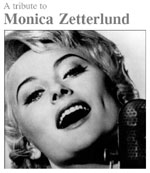
By Matt Schudel
Washington Post Staff Writer
Sunday, May 15, 2005; Page N01
This is the 10th year the Kennedy Center has presented the Mary Lou Williams Women in Jazz Festival. More than 100 women have performed in that time, but there remains one woman whose music has been conspicuously absent from the festival: Mary Lou Williams.
Her name has long hovered on the misty periphery of jazz awareness, but this year we can finally see why she is more than a figurehead for the festival that honors her career. At long last, the Mary Lou Williams Women in Jazz Festival, which runs Wednesday through Saturday, will fully earn its name.
On Friday, vibraphonist and bandleader Cecilia Smith will present a full evening of Williams's compositions entitled the Mary Lou Williams Resurgence Project. The music, ranging from classic swing tunes to ambitious sacred works, will be performed by small groups, a big band and 50 massed voices of the magnificent Morgan State University Choir.
Geri Allen, who portrayed Williams in the 1996 Robert Altman film "Kansas City," will perform Williams's 12-part "Zodiac Suite" on Saturday (on a triple bill with the Dixieland ensemble Jazzberry Jam and singer Rene Marie). Allen is believed to be the first pianist to perform the suite since Williams wrote and played it in 1945.
"For the first time," says Peter O'Brien, a Jesuit priest who managed Williams's career for 11 years and knew her well in the final years of her life, "the Mary Lou Williams Jazz Festival truly represents Mary Lou Williams."
The idea of honoring Williams, and women in jazz generally, came from Billy Taylor, the Kennedy Center artistic adviser and Johnny Appleseed of jazz. It takes place each year in May, the month of both Williams's birth 95 years ago and her death in 1981.
During her 71 years, she was a remarkable, one-of-a-kind artist. She may have been the finest prodigy jazz has ever produced -- a full-fledged professional at 12, who played with Duke Ellington's band when she was in her early teens; a pianist whose abilities were said to rival those of Art Tatum and Bud Powell; a composer of irresistible melodies and forward-thinking harmonics; the hostess of a jazz salon that spawned some of the most imaginative music of its age. She continued to develop new ideas and modes of expression until the end of her life.
She wasn't just "good for a woman" -- she was superior to almost everyone.
Musicians still revere Williams, but to the wider public, and even to the shrinking quarter that listens to jazz, she's Mary Who? The music alone will have to show why a small but devoted coterie believes Mary Lou -- to anyone in jazz she's just "Mary Lou" -- deserves a place alongside the most honored names in jazz.
"Genius," says Smith, who has studied Williams's music for the past four years. "Is there another word for her? I don't think so."
On her expedition of musical archaeology, Smith has made a number of discoveries. One of the works she will present Friday is Williams's 1962 oratorio for orchestra and choir, "St. Martin de Porres" (also called "Black Christ of the Andes," for the first black saint of the Roman Catholic Church from the Americas).
"It's so magnificent," says Smith, "it makes you sit and reflect for a minute."
Read the complete article...




























